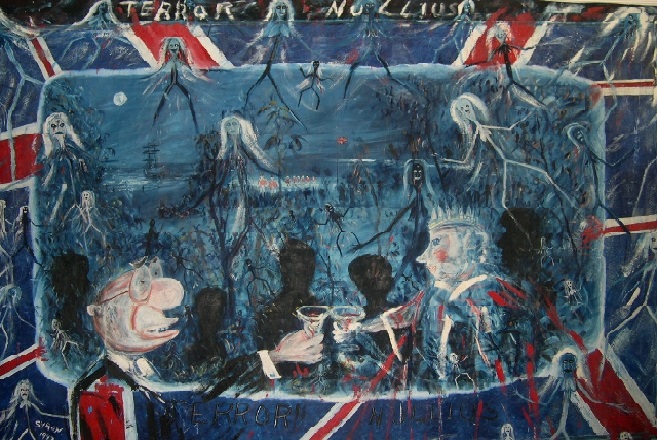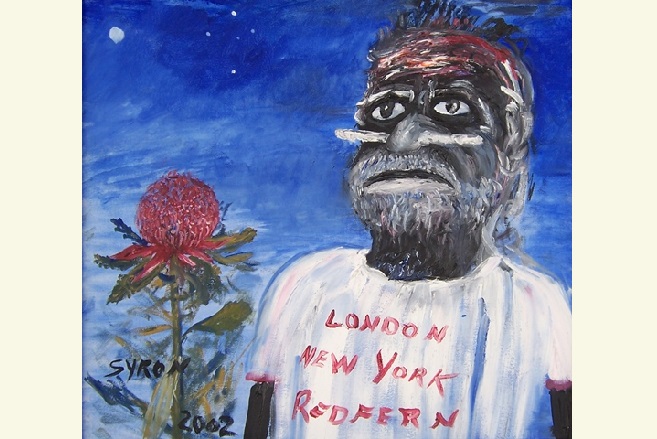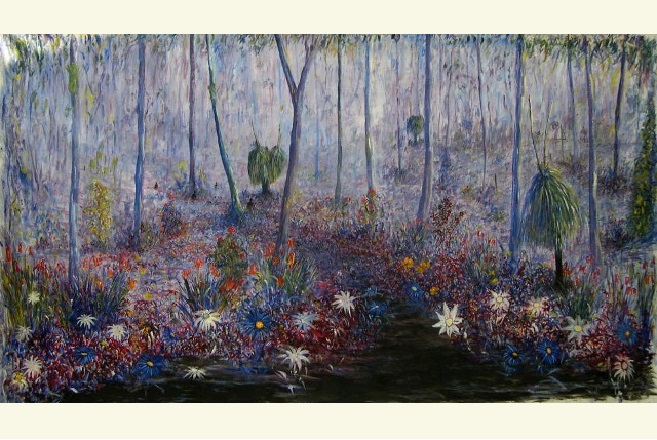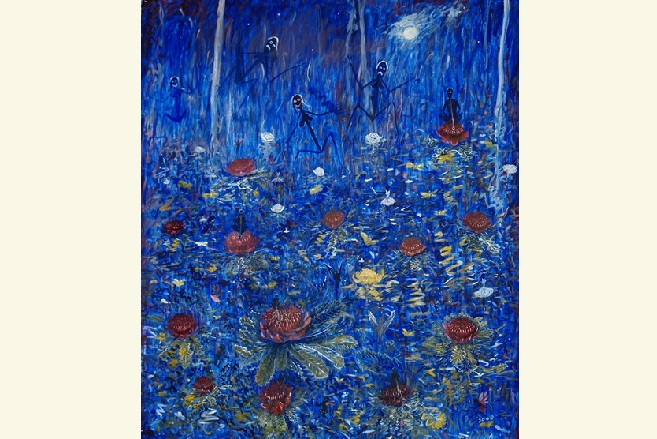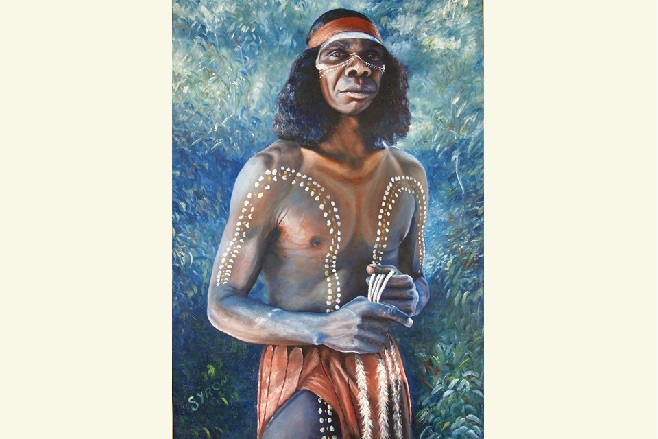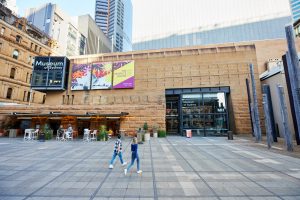Dispossessed of his land by colonialism and white mans’ law, Gordon Syron committed a crime for which he spent 10 years in goal. It was there he learnt to paint.
Possessed by a talent for repetition and an unrelenting desire to facilitate change, Syron paints, repaints and paints again the story of ‘Invasion Day.’
The landing of the First Fleet has taken its place in the modern Australian Day psyche as the day an English colony set up shop here. But to Syron and the people of the First Nation it was far more significant than that. Invasion Day was the day Aboriginal life changed forever.
Syron has painted this scene hundreds of times. And he does it with flair—positioning his people on the edge of Sydney Cove watching, waiting—wondering about the tall ships coming through the Heads.
His paintings provide a relentless commentary on white Australian's culture and cultural practices. He does it with humour, he does it with anger, and he does it with unwavering commitment to his story, the Aboriginal story.
By painting this event through the eyes of the Aboriginal people standing on the shore watching what is about to unfold, we as audience stand in their shoes too. We stand and watch with apprehension and curiosity as the Redcoats row ashore. And because we know exactly how the story goes, it makes the viewing even more powerful. It’s a kind of Groundhog Day experience.
Some of Syron’s Invasion Days’ are playful—he paints the Redcoats in rowing boats, he brings Santa and the Pope in by boat. He comments on illegal immigration and boat people. “The Redcoats were the first boat people”, says Syron. His paintings provide a relentless commentary on white Australian’s culture and cultural practices. He does it with humour, he does it with anger, and he does it with unwavering commitment to his story, the Aboriginal story.
He’s a marvellous artist and one who shows his skill and versatility year after year. He loves to paint with blue on his brush and favours ultramarine and violet. He paints his homelands of the Worimi people of the Forster-Tuncurry area of NSW, as rich rainforests flush from rain and abundant with wildflowers. He paints portraits of significant others like the larger than life Mum Shirl and David Gulpilil.
The Museum of Sydney has two Invasions Days – they are located on the second floor in the Storylines Gallery.
Drop in to MOS and have a look this Invasion Day!
For more information about the works on display in the slideshow above, read what Gordon has written about them:
Where the wildflowers once grew
“This painting is the third of a series that I have painted of rainforests from Sydney to Cairns along the coast. All of Sydney must have been a beautiful rainforest with many Coroborree Grounds which were important meeting places for Aboriginal people. Also when I was in prison for 10 years in Her Majesty’s prison then I had this reoccurring vision of this rainforest where I grew up.
This is Old Minimbah Land where Grandma used to live. It is CROWN LAND and my Father’s name, Robert John Syron is on the map. This land is part of the Old Coroborree Grounds. This painting is the result of trying to create a painting/photgraph of my memory of just how majestic the rainforest, flowers and trees were of our Land.
The mining companies came through this area and took more than a foot-deep of top soil off thousands of acres of our land. They took all the elements and goodness out of the soil. Now the wildflowers don’t grow anymore. When I was young I could lean off my horse and in seconds have an armful of breathtakingly beautiful wildflowers, I wouldn’t even have to get off my horse to pick them. This Land was sacred to me that is why I chose to paint about it.”
The Waratah Forest
“I grew up in a forest with beautiful trees and wildflowers were everywhere. My Grandmother remembers when there were waratahs in our forest. This was because the poachers took them all to sell in Sydney. So I created out of my fantasy, a forest of giant waratahs in this series of paintings where Aboriginal and Fairies live like Kings.
This painting inspired me to paint seriously the body of work on Black Fairies.
This story is about my paternal grandmother so it is a Worimi Story, North New South Wales, Australia, a true Australian story of what happened to Australia’s land and its’s Indigenous People. Because my Grandmother told me that story, I was able to paint that story I’m glad I can hang onto that story through my paintings. I am so glad that I did not have to paint dots to make money.”
And they never asked us for our land
Elaine Syron has said of this work “This photo was taken the night of the Parliament House Art Prize where Gordon won the College of Fine Arts Professional Development Award in 2009 and that is why he is wearing a suit.”
The Dreaming Man
“The first of a series on how a traditional Aboriginal comes ‘to Redfern’, to the ‘big smoke.’ He comes from the ‘bush’, to get a job, to see relatives and friends, to see Sydney and does he get a shock, at all them things. The living conditions are better at home. He is caught in the crossroads of life, stranded, no money to get back home, no hope even for a job and what is left? If he stays in Redfern then the chance of going to jail is great. He can then have drugs and alcohol under police supervision. The Dreaming Man is lost in time, the poor bastard.
There are Dreaming Aboriginal Women too. Not just men. Kids, the whole lot too. There are a lot of Aboriginal people who dream. The truth is they used to own all this land. You gotta have a dream or you don’t go nowhere. “The Dreaming Man” was created from many different perspectives. There is a sadness about this first one. Southern Cross shows it is Australia. The Waratah shows it is New South Wales. I used to see the Waratah on my brother Kevin’s boxing shorts. He held the NSW featherweight title.”
Thanks to Elaine Pelot-Syron for providing these stories.


